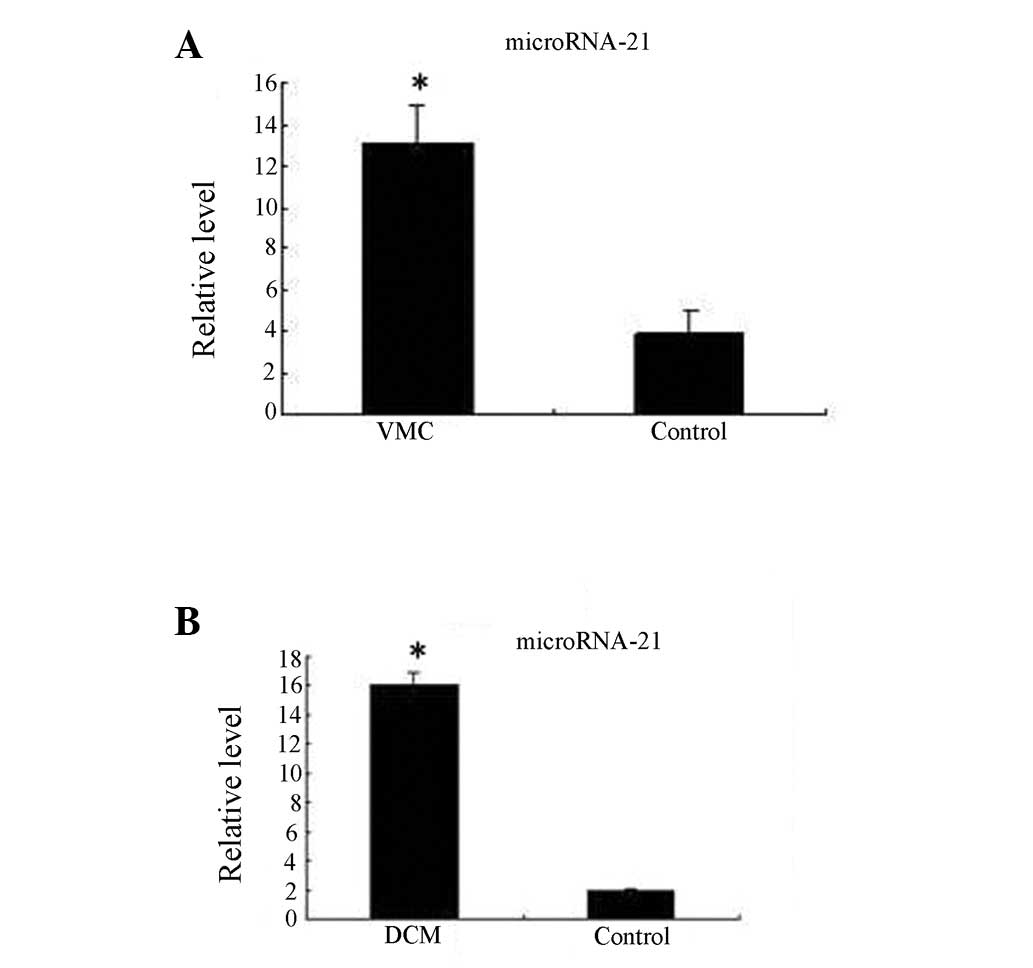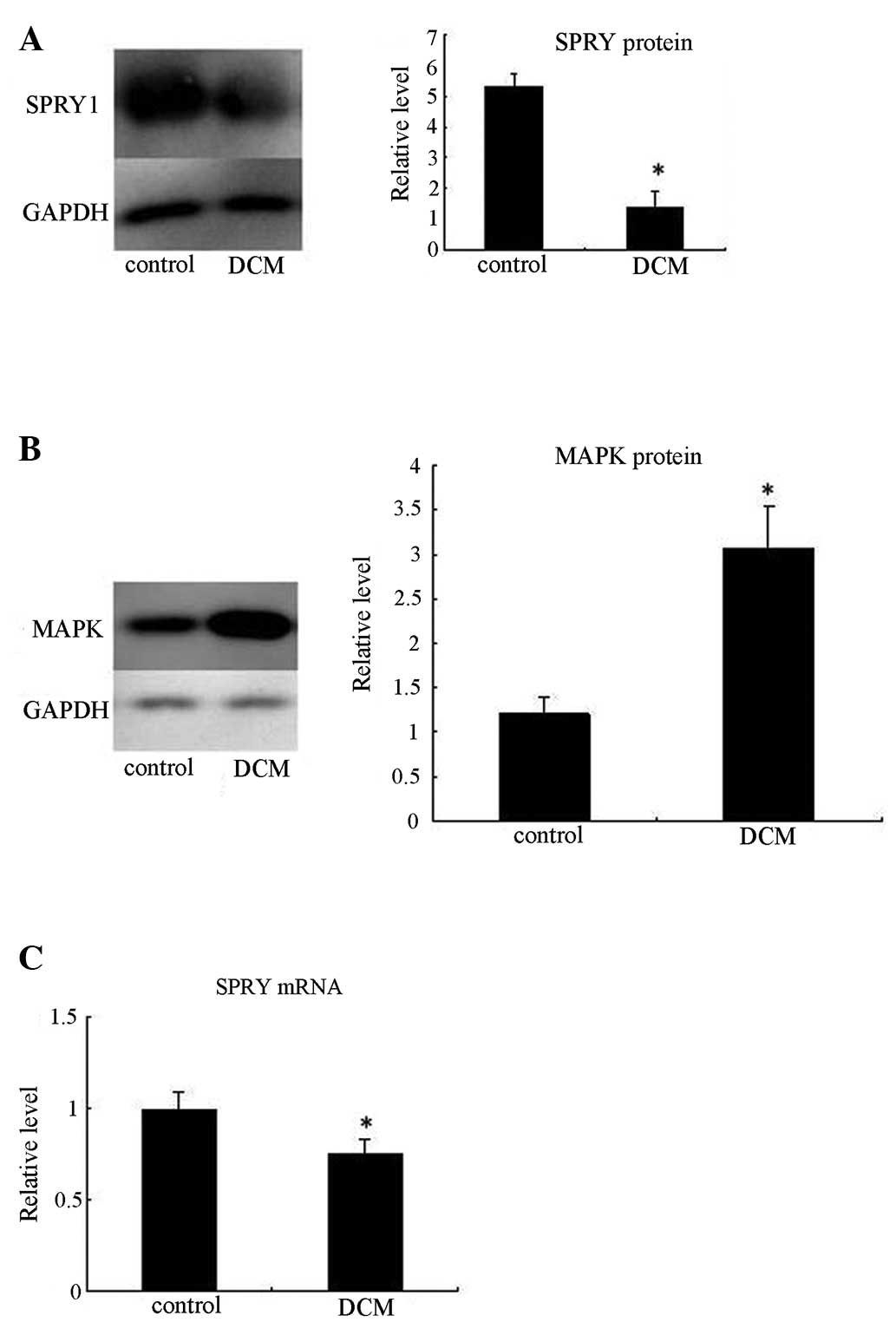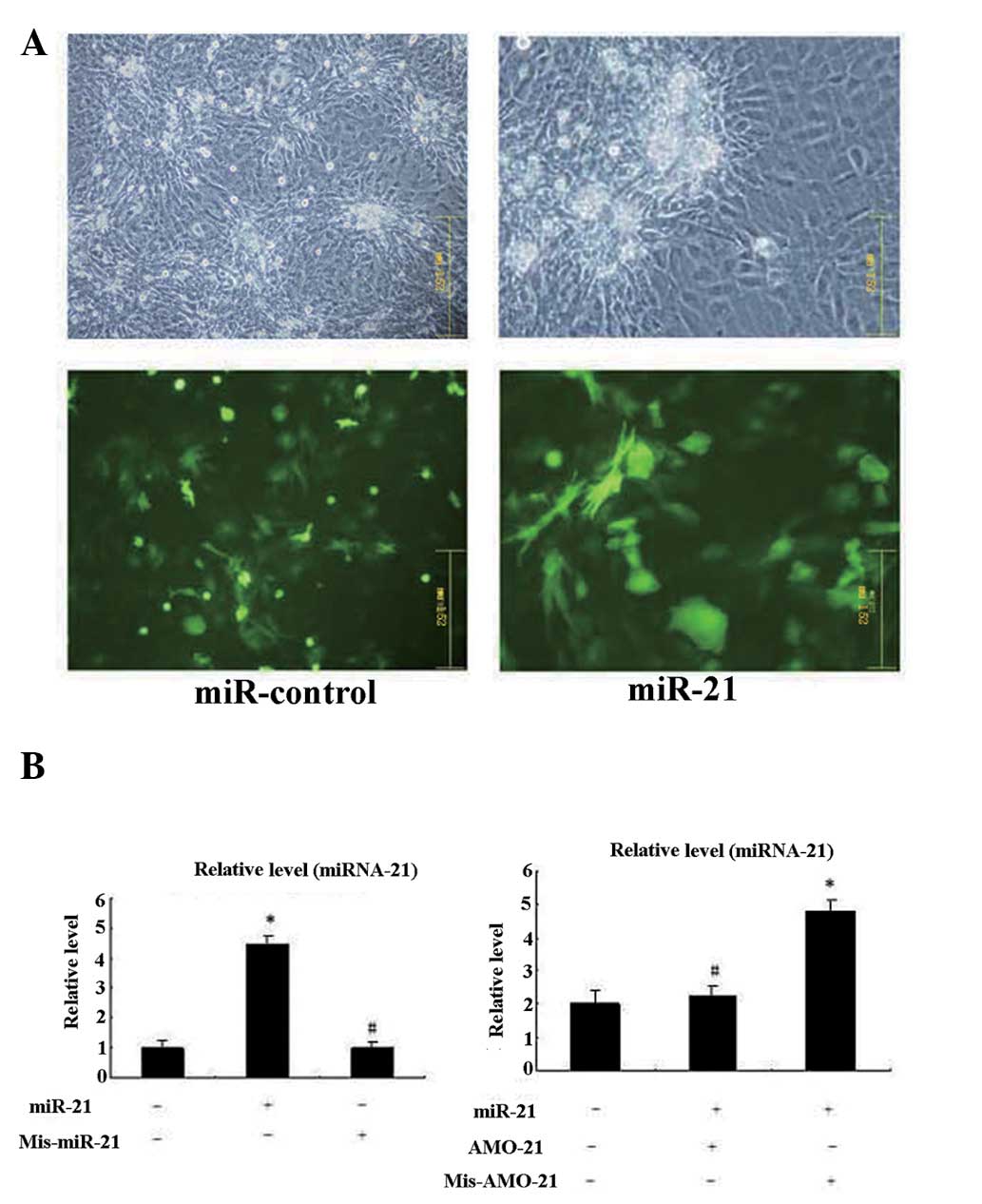|
1
|
Richardson P, McKenna W, Bristow M, et al:
Report of the 1995 World Health Organization/International Society
and Federation of Cardiolgy Task Force on the definition and
classification of cardiomyopathies. Circulation. 93:841–842. 1996.
View Article : Google Scholar : PubMed/NCBI
|
|
2
|
Feldman AM and McNamara D: Myocarditis. N
Engl Med. 343:1388–1398. 2000. View Article : Google Scholar
|
|
3
|
Kawai C: From myocarditis to
cardiomyopathy: mechanisms of inflammation and cell death.
Circulation. 99:1091–1100. 1999. View Article : Google Scholar : PubMed/NCBI
|
|
4
|
Miyamoto SD, DeBiasi RL and Long CS: Novel
therapeutic targets in viral myocarditis. Future Virol. 3:373–381.
2008. View Article : Google Scholar
|
|
5
|
Zhao Y, Samal E and Srivastava D: Serum
response factor regulates a muscle-specific microRNA that targets
Hand2 during cardiogenesis. Nature. 436:214–222. 2005. View Article : Google Scholar : PubMed/NCBI
|
|
6
|
Lin Z, Murtaza I, Wang K, et al: miR-23a
functions downstream of NFATc3 to regulate cardiac hypertrophy.
Proc Natl Acad Sci USA. 106:12103–12108. 2009. View Article : Google Scholar : PubMed/NCBI
|
|
7
|
Shan ZX, Lin QX, Fu YH, et al: Upregulated
expression of miR-1/miR-206 in a rat model of myocardial
infarction. Biochem Biophys Res Commun. 381:597–601. 2009.
View Article : Google Scholar : PubMed/NCBI
|
|
8
|
Goren Y, Kushnir M, Zafrir B, Tabak S,
Lewis BS and Amir O: Serum levels of microRNAs in patients with
heart failure. Eur J Heart Fail. 14:147–154. 2012. View Article : Google Scholar : PubMed/NCBI
|
|
9
|
Seto AG and van Rooij E: Circulating
microRNAs to identify human heart failure. Eur J Heart Fail.
14:118–119. 2012. View Article : Google Scholar : PubMed/NCBI
|
|
10
|
Karp X and Ambros V: Developmental
biology: encountering microRNAs in cell fate signaling. Science.
310:1288–1289. 2005. View Article : Google Scholar : PubMed/NCBI
|
|
11
|
Cheng Y, Zhu P, Yang J, Liu X, Dong S,
Wang X, Chun B, Zhuang J and Zhang C: Ischaemic
preconditioning-regulated miR-21 protects heart against
ischaemia/reperfusion injury via anti-apoptosis through its target
PDCD4. Cardiovasc Res. 87:431–439. 2010. View Article : Google Scholar : PubMed/NCBI
|
|
12
|
Cai C, Masumiya H, Weisleder N, et al:
MG53 nucleates assembly of cell membrane repair machinery. Nat Cell
Biol. 11:56–64. 2009. View
Article : Google Scholar : PubMed/NCBI
|
|
13
|
Hacohen N, Kramer S, Sutherland D, Hiromi
Y and Krasnow MA: Sprouty encodes a novel antagonist of FGF
signaling that patterns apical branching of the Drosophila airways.
Cell. 92:253–263. 1998. View Article : Google Scholar : PubMed/NCBI
|
|
14
|
Minowada G, Jarvis LA, Chi CL, Neubüser A,
Sun X, Hacohen N, Krasnow MA and Martin GR: Vertebrate Sprouty
genes are induced by FGF signaling and can cause chondrodysplasia
when overexpressed. Development. 126:4465–4475. 1999.PubMed/NCBI
|
|
15
|
Cai C, Masumiya H, Weisleder N, Pan Z,
Nishi M, Komazaki S, Takeshima H and Ma J: MG53 regulates membrane
budding and exocytosis in muscle cells. J Biol Chem. 284:3314–3322.
2009. View Article : Google Scholar : PubMed/NCBI
|
|
16
|
Cai C, Weisleder N, Ko JK, Komazaki S,
Sunada Y, Nishi M, Takeshima H and Ma J: Membrane repair defects in
muscular dystrophy are linked to altered interaction between MG53,
caveolin-3 and dysferlin. J Biol Chem. 284:15894–15902. 2009.
View Article : Google Scholar : PubMed/NCBI
|
|
17
|
Cao C, Zhang Y, Weisleder N, et al: MG53
Constitutes a primary determinant of cardiac ischemic
preconditioning. Circulation. 121:2565–2574. 2010. View Article : Google Scholar : PubMed/NCBI
|
|
18
|
Thum T, Gross C, Fiedler J, et al:
MicroRNA-21 contributes to myocardial disease by stimulating MAP
kinase signalling in fibroblasts. Nature. 456:980–984. 2008.
View Article : Google Scholar : PubMed/NCBI
|
|
19
|
Klingel K, Hohenadl C, Canu A, Albrecht M,
Seemann M, Mall G and Kandolf R: Ongoing enterovirus-induced
myocarditis is associated with persistent heart muscle infection:
quantitative analysis of virus replication, tissue damage, and
inflammation. Proc Natl Acad Sci USA. 89:314–318. 1992. View Article : Google Scholar
|
|
20
|
Kandolf R, Selinka H and Klingel K:
Pathogenesis of Coxsackievirus B infections. Molecular Biology of
Picornaviruses. Semler BL and Wimmer E: American Society of
Microbiology; Washington, DC: pp. 405–413. 2002, View Article : Google Scholar
|
|
21
|
Mestroni L, Maisch B, McKenna WJ, Schwartz
K, Charron P, Rocco C, Tesson F, Richter A, Wilke A and Komajda M:
Guidelines for the study of familial dilated cardiomyopathies.
Collaborative Research Group of the European Human and Capital
Mobility Project on Familial Dilated Cardiomyopathy. Eur Heart J.
20:93–102. 1999. View Article : Google Scholar : PubMed/NCBI
|
|
22
|
McMurray JJV, Adamopoulos S, Anker SD, et
al: ESC guidelines for the diagnosis and treatment of acute and
chronic heart failure 2012: The Task Force for the Diagnosis and
Treatment of Acute and Chronic Heart Failure 2012 of the European
Society of Cardiology. Developed in collaboration with the Heart
Failure Association (HFA) of the ESC. Eur J Heart Fail. 14:803–869.
2012.
|
|
23
|
Pfaffl MW: A new mathematical model for
relative quantification in real-time RT-PCR. Nucleic Acids Res.
29:e452001. View Article : Google Scholar : PubMed/NCBI
|
|
24
|
Pang L, Koren G, Wang Z and Nattel S:
Tissue-specific expression of two human Ca(v)1.2 isoforms under the
control of distinct 5′ flanking regulatory elements. FEBS Lett.
546:349–354. 2003.PubMed/NCBI
|
|
25
|
Luo X, Xiao J, Lin H, Li B, Lu Y, Yang B
and Wang Z: Transcriptional activation by stimulating protein 1 and
post-transcriptional repression by muscle-specific microRNAs of
IKs-encoding genes and potential implications in regional
heterogeneity of their expressions. J Cell Physiol. 212:358–367.
2007. View Article : Google Scholar
|
|
26
|
Caplen NJ, Parrish S, Imani F, Fire A and
Morgan RA: Specific inhibition of gene expression by small
double-stranded RNAs in invertebrate and vertebrate systems. Proc
Natl Acad Sci USA. 98:9742–9747. 2001. View Article : Google Scholar : PubMed/NCBI
|
|
27
|
Lewis BP, Shih IH, Jones-Rhoades MW,
Bartel DP and Burge CB: Prediction of mammalian microRNA targets.
Cell. 115:787–798. 2003. View Article : Google Scholar : PubMed/NCBI
|
|
28
|
Brennecke J, Stark A, Russell RB and Cohen
SM: Principles of microRNA-target recognition. PLoS Biol.
3:e852005. View Article : Google Scholar : PubMed/NCBI
|
|
29
|
Cannell IG, Kong YW and Bushell M: How do
microRNAs regulate gene expression? Biochem Soc Trans.
36:1224–1231. 2008. View Article : Google Scholar : PubMed/NCBI
|
|
30
|
Griffiths-Jones S: The microRNA registry.
Nucleic Acids Res. 32:D109–D111. 2004. View Article : Google Scholar : PubMed/NCBI
|
|
31
|
Lee Y, Ahn C, Han J, Choi H, Kim J, Yim J,
Lee J, Provost P, Rådmark O, Kim S and Kim VN: The nuclear RNase
III Drosha initiates microRNA processing. Nature. 425:415–419.
2003. View Article : Google Scholar : PubMed/NCBI
|
|
32
|
Lund E, Güttinger S, Calado A, Dahlberg JE
and Kutay U: Nuclear export of microRNA precursors. Science.
303:95–98. 2004. View Article : Google Scholar
|
|
33
|
Khvorova A, Reynolds A and Jayasena SD:
Functional siRNAs and miRNAs exhibit strand bias. Cell.
115:209–216. 2003. View Article : Google Scholar : PubMed/NCBI
|
|
34
|
Xu HF, Li YH, Chen Y and Cheng LB: The
expression of dystrophin in human viral myocarditis and dilated
cardiomyopathy. Fa Yi Xue Za Zhi. 22:12–14. 2006.(In Chinese).
|
|
35
|
Xu HF, Chen JL, Da XP, Wu KR, Liu GQ, Zhao
ZQ and Han XH: Expression of CAR in myocardial of viral myocarditis
and dilated cardiomyopathy. Fa Yi Xue Za Zhi. 26:328–331. 2010.(In
Chinese).
|
|
36
|
Kawai C: From myocarditis to
cardiomyopathy: mechanisms of inflammation and cell death: learning
from the past for the future. Circulation. 99:1091–1100. 1999.
View Article : Google Scholar : PubMed/NCBI
|
|
37
|
Pearson G, Robinson F, Beers Gibson T, Xu
BE, Karandikar M, Berman K and Cobb MH: Mitogen-activated protein
(MAP) kinase pathways: regulation and physiological functions.
Endocr Rev. 22:153–183. 2001.PubMed/NCBI
|
|
38
|
Heldin CH, Miyazono K and ten Dijke P:
TGF-beta signaling from cell membrane to nucleus through SMAD
proteins. Nature. 390:465–471. 1997. View
Article : Google Scholar : PubMed/NCBI
|
















